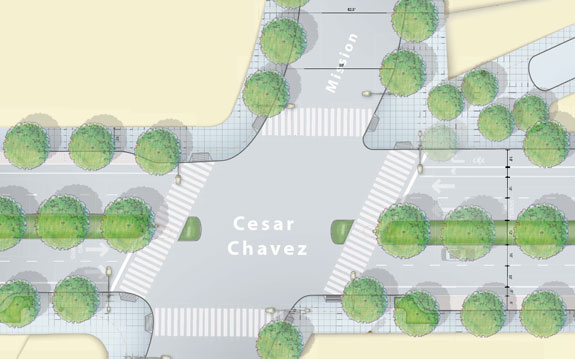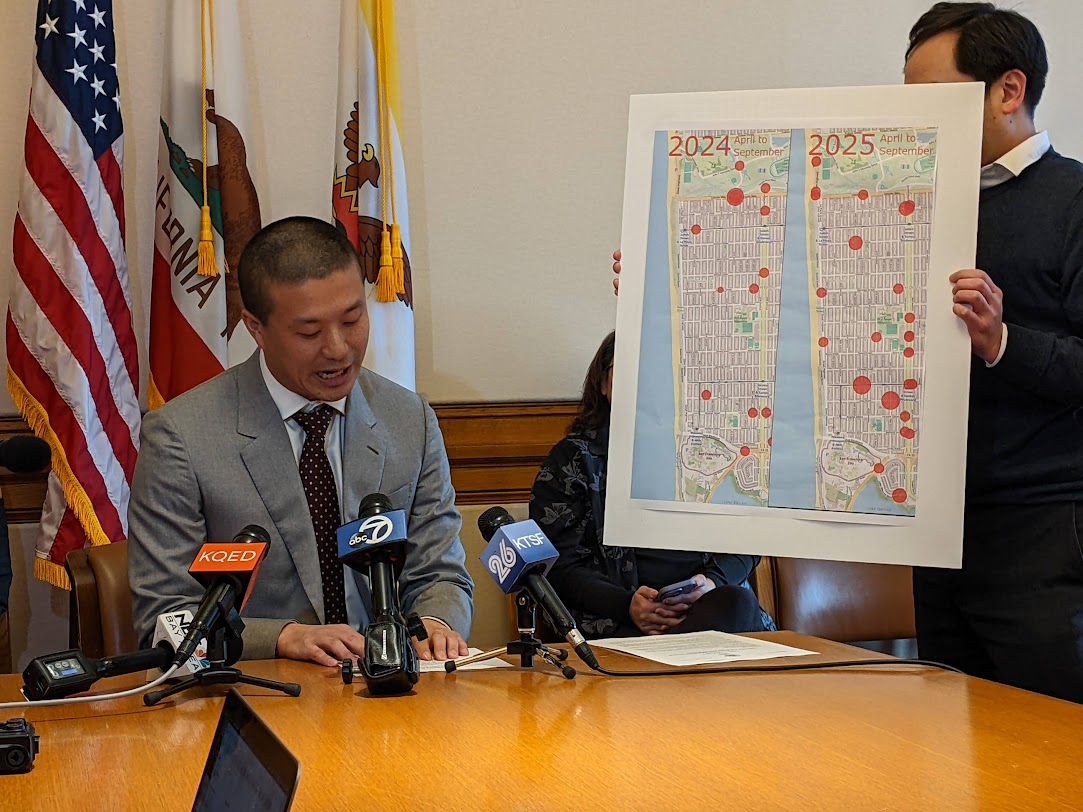An SFMTA hearing room erupted into applause Friday, November 19, when John Newlin, a hearing officer at the SFMTA, ruled that the massive Cesar Chavez Street redesign should move on to the full SFMTA Board. Supporters of the plan, led by CC Puede, the San Francisco Bicycle Coalition, and other community groups, swamped opposition. The hearing was the proposal’s first formal test.
If the plan continues to sail through approvals, Cesar Chavez from Hampshire Street to Guerrero will soon slim down from three vehicle traffic lanes in each direction to two, with the freed-up space going to bike lanes, strategic turn pockets, and a wide landscaped median. Extensive corner bulbouts, additional greening, and stormwater capture enhancements round out the design elements. Work should begin next summer, following sewer replacement construction. Crews are scheduled to start ripping up the street at Hampshire in February, then move west. The streetscape improvements will shadow the sewer work, with workers zipping the street back together as the sewer dig moves on to the next segment.
Though city officials had expressed early support for the plan, initiated in early 2006 by a neighborhood petition drive, and several large community meetings over the past few years had unearthed little protest, tension arose just before the hearing when some parents at the Leonard Flynn Elementary School on Cesar Chavez and Harrison raised objections. They were upset at the removal of the left turn option onto Harrison from westbound Cesar Chavez, which some parents use to drive their children to school.
Ironically, parents had rallied for safety at that very corner in 2003 to protest the traffic, not efforts to contain it. Two Flynn students, a brother and sister, were hit by the driver of a pickup truck running the red on Cesar Chavez at Harrison. Both survived, but the girl missed a year of school. At the time, the intersection lacked even a “Walk/Don’t Walk” signal, and the city was dragging its heels about installing one. After the demonstration, implementation sped up, and a countdown signal appeared.

According to Andres Power of the Planning Department, who has been riding herd on the Cesar Chavez plan along with representatives from the SFMTA, Public Utilities Commission, and Department of Public Works, the proposed left turn ban, bulbouts, and median are intended to prevent danger, not invite it. Still, e-mail messages circulating days before the hearing predicted dire consequences should the left turn ban be implemented as proposed. Power and the SFMTA’s Mike Sallaberry agreed to meet with the concerned parents and attempt some reconciliation. Evidently, the hearing officer agreed that a dust up over one intersection shouldn’t derail the entire project.
A few other speakers objected to the plan, with varying degrees of heat. One critic denounced the whole idea, saying it would cause congestion and thus create pollution. Sallaberry agreed that congestion would increase at the peak rush hour but showed a graph demonstrating how underutilized the street now is the other 23 hours every day. Another speaker who has lived on Cesar Chavez for many years expressed concern about loss of parking, though she mistakenly attributed this to the bike lanes rather than the pedestrian bulbouts. The total number of spaces lost should be around 30, sprinkled over the length of the street from Hampshire to Guerrero.
Otherwise, the hearing turned into a lovefest for the redesign. Renee Saucedo of the Day Labor Program came out in firm support and thanked CC Puede for its work. She called for benches for the day laborers, an idea that was echoed by a subsequent speaker. Chicken John Rinaldi, former mayoral candidate, owns an art installation building on Cesar Chavez and described the difficulty patrons now have in crossing the street to come to his events. Leonard Flynn parent Rosi Bustamante walks her children to the school and spoke of looking forward to doing so more safely. Altogether, 16 speakers voiced their enthusiasm for the project, a large turnout for a low-profile weekday morning hearing.
This wave of support showed the benefits of slow going and steady community outreach. The first mention of the project in the San Francisco Chronicle in fall 2005 brought a torrent of threats to stop it dead. Following the 2006 petition drive, which garnered over 600 signatures, CC Puede held several meetings and other events before the city got involved that addressed initial concerns about potential spillover traffic, loss of parking, and congestion. Early critics had time to be heard and to contribute their own ideas, and gradually opposition faded. In 2007, CC Puede hand-delivered a letter explaining the project and its goals in English and Spanish to every door along Cesar Chavez and several side streets, inviting neighbors to speak up and ask questions.
Even the Leonard Flynn parents who objected to the left turn ban at Harrison supported the project overall. They just felt blindsided by the specifics, some of which had been fuzzy at the community meetings. The project itself was well known, however, and neighbors had had time to get used to the idea.
Meanwhile, the Planning Department has just begun to tackle the eastern segment of Cesar Chavez, including the “hairball,” the nasty 101 freeway maze, and the 280 interchange. Ilaria Salvadori and other representatives of Planning have already met with neighbors, merchants, and advocates to plan a series of community meetings, surveys, and a walking tour to come up with a design that will improve pedestrian, bicycle, and transit travel along the forlorn eastern strip, while still accommodating industrial uses and truck traffic. An early December kickoff is planned.






